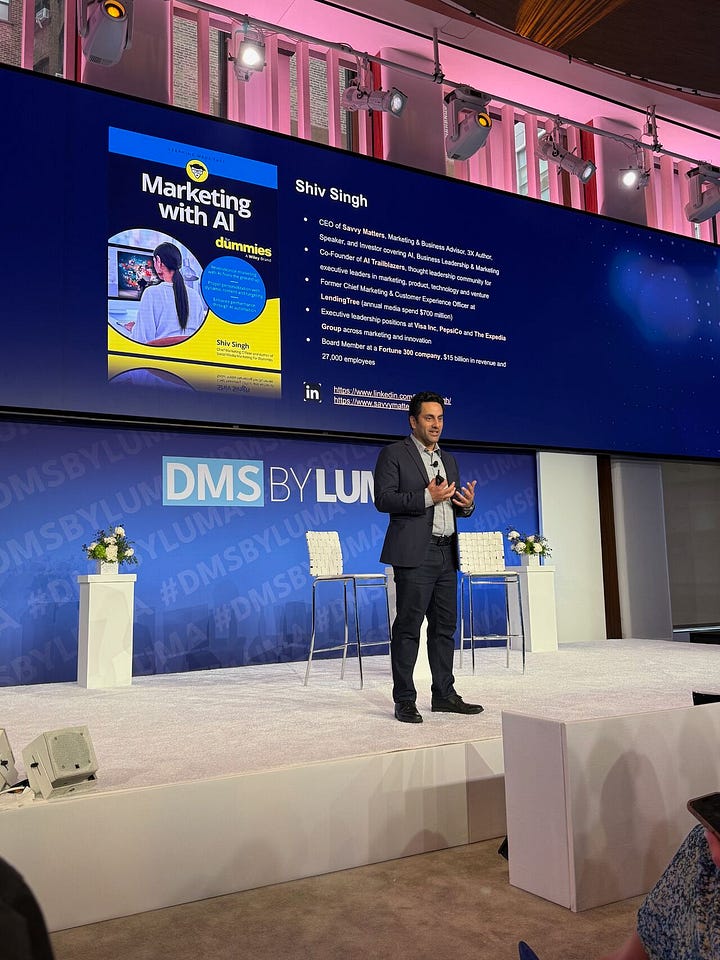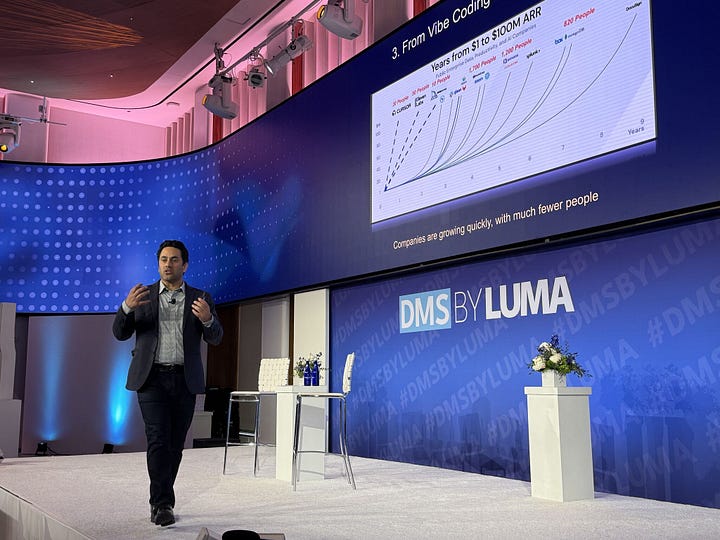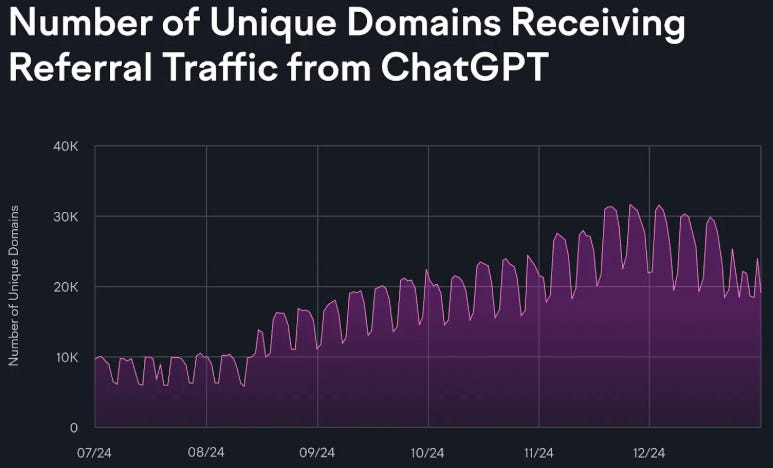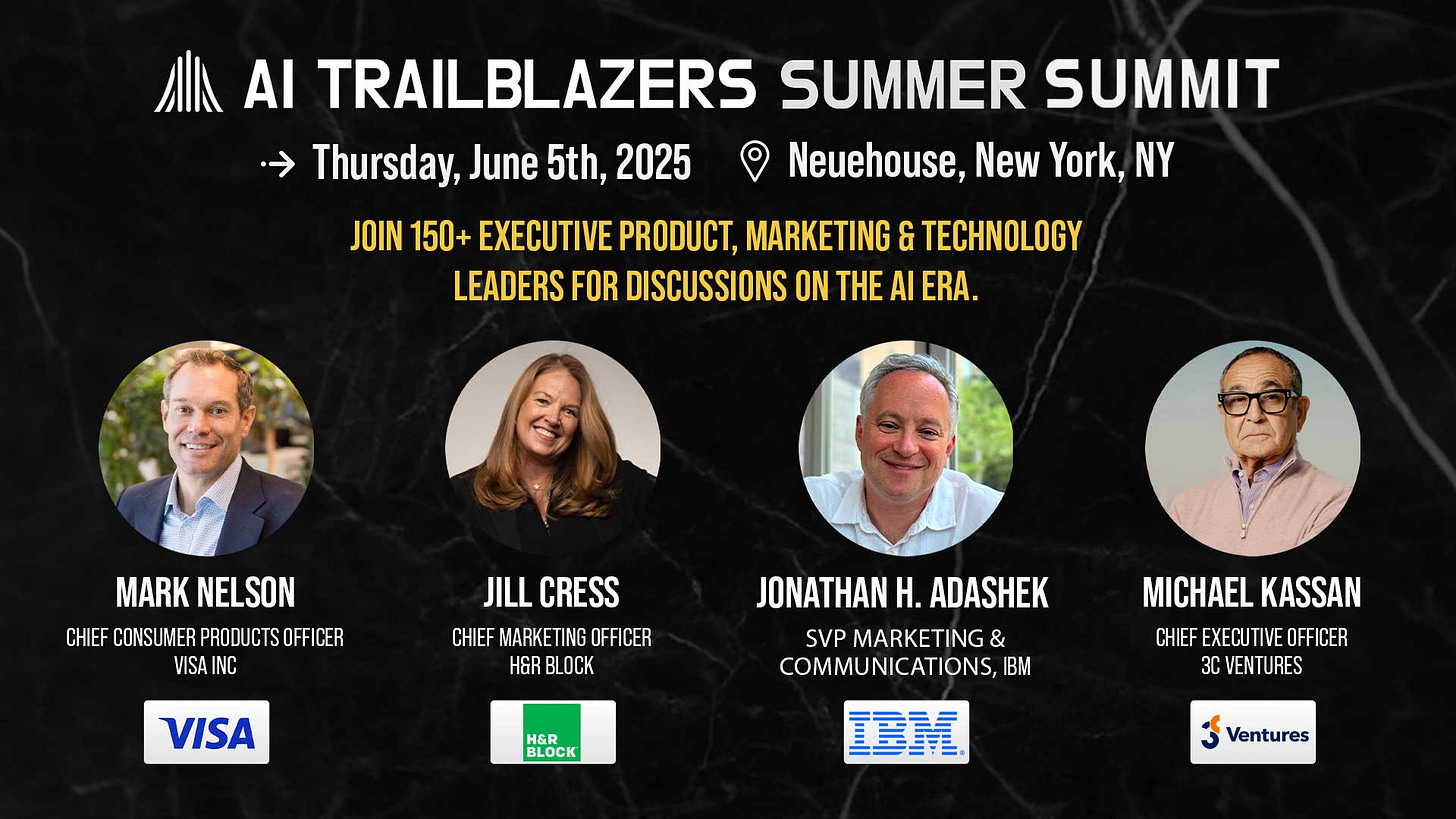Will the Model Remember You?
Ahead of the AI Trailblazers Summit: A Field Guide to the Answer Economy
Over the past few weeks, I’ve traveled to Europe, the East Coast, and back home to San Francisco, working with companies at the forefront of the AI business transformation. From in-depth conversations about the future of work and the evolving role of go-to-market leaders, to the complexities of media planning in the AI era and the reinvention (or possible demise) of Google Search, it’s been an exciting few weeks.
I also marked another trip around the sun, which brought some deeper reflection on the future of work, life, and play, and how I want to spend my time on this planet. Some of these thoughts, (though not the last), will be central to next week’s AI Trailblazers Summer Summit. Take a look at the incredible speaker lineup below the main piece and join us at the summit, as well as at the Women in AI Breakfast at the New York Stock Exchange the following morning. We have just a few spots left.
As I’ve listened to leaders across sectors wrestle with the rapid AI shifts underway, one topic keeps surfacing: what does the future of search look like when it’s no longer built for clicks but for answers?
Search Is Evolving—But Not How You Think
I’ve been discussing the rise of the answer economy for the past year (here, here and here for example), but two recent developments have sparked a broader wave of interest across the business world. The first was ChatGPT surpassing 800 million active weekly users, doubling from 400 million just a few months earlier. It’s clear that people are shifting toward chat interfaces, especially younger users who increasingly see them as a replacement for, or supplement to, traditional search.
The second moment came during a DOJ antitrust hearing, when Eddy Cue mentioned a decline in Google searches within the Safari browser. That comment triggered a one-day 7.5% drop in Alphabet’s market cap and raised fears that Google Search might be under serious threat. While the stock has since more than rebounded, the remark captured headlines and stirred debate.
Both of these realities can exist at the same time. Consumers are moving toward conversational AI, and yet Google remains well-positioned for continued growth. At the recent Google I/O conference, the company revealed that Google Gemini now has 400 million active monthly users. That announcement, among others, helped restore investor confidence and pushed Alphabet’s stock higher. Google’s broader rollout of “AI Mode,” along with other product enhancements, also played a role in driving renewed momentum.
In the popular narrative that says “Search is dying, therefore Google is dead,” what’s often overlooked is that Google pioneered large language model research. The original Transformer infrastructure paper, Attention Is All You Need, came out of Google in 2017. Beyond that, Google still runs the most advanced and scaled advertising infrastructure in the world. While newer AI companies are just starting to build their advertising infrastructure, Google already operates at tremendous scale.
And regardless of the headlines, Google continues to understand human intent better than anyone because of its scale. Whether someone types in a keyword or a full sentence, Google knows what they mean — and that still matters (queries in Chat interfaces average 23 words versus 4 in Google Search). Other research shows that cost-per-click in Google has increased 12% over the past year, and the cost per lead has risen by 5%, now averaging $71. Many small businesses are seeing strong returns and are actually planning to increase their ad spend on Google.
But there’s another important albeit conflicting factor to consider as well: the rise of the Zero Click Phenomenon. While users still rely on Google (in fact, it's used 373 times more than ChatGPT), they are clicking on traditional search result links less often. About 80% of users now engage with AI Overviews in at least 40% of their searches, significantly reducing the amount of clicking for certain terms according to Bain Consulting.
This raises two important questions. Google isn't going anywhere, but could its core search advertising business be vulnerable to changes driven by its own technology and companies like OpenAI, Anthropic and Perplexity? And what does this potential shift mean for businesses? The answer is more complex than it seems.
What does this mean for Corporate America?
So where does this leave us? AI is reshaping not just how consumers find information, but how they act on it. Here’s how smart businesses are adjusting. After all, you don’t want to get Chegged, as I discussed in a separate piece recently.
1. Know how your brand and products show up.
This is the new table stakes. If you don’t know how your brand or products are being represented in large language models, it’s hard to take meaningful action. The way LLMs describe you can change quickly and unexpectedly. That’s why it’s essential to use tools like Brandrank.ai, Profound and BrandLight to actively monitor your presence across ChatGPT, Perplexity, Claude, Gemini, and more. One Fortune 50 team I met had just launched a flagship product, but ChatGPT still surfaced information about an older, buggy version. It wasn't just outdated, it was brand-damaging. They had no idea this was happening. Without visibility into LLMs, you're flying blind in a channel millions are already using.
Google is beginning to move in this direction by integrating more data into its Search Console. It has announced that Search Console will soon show performance data for AI Overviews. It is the first important step and I’m willing to bet their product roadmap has a lot more to help you understand how Gemini interprets and surfaces your brand and products. OpenAI is also exploring similar tracking capabilities. Regardless, brands need to take responsibility for monitoring themselves and their products. We’re now entering what some are calling the era of Answer Engine Optimization (AEO) or Generative Engine Optimization (GEO) where the goal isn’t just ranking on a page, but being the source the model references directly in its synthesized responses. Winning in this world begins with knowing how you rank.
2. What’s old is new again.
Back in the late 1990s at Babson College, my first real job was as a ‘Webmaster,’ a title the Head Librarian graciously gave me when she took kindly to me and hired me into a role that required me to first learn HTML. Today, that job feels newly relevant. Your site isn’t just a destination - it’s the ingredients for the answer engines. As Pete Blackshaw of Brandrank.ai, who I’ll be interviewing at the AI Trailblazers Summer Summit, often says, brands need to close the answer divide. That means closing the gap between what consumers are asking large language models and what those models are able to deliver after having pre-trained on publicly available data across the Internet.
The fix starts by making your website answer-ready. It’s time to put your website back at the center of your digital strategy. That means having the right content in place, ensuring it’s easily accessible to both humans and AI, backing up your claims with verifiable proof and third-party validation, and making sure it’s clean, easy to parse, and available in all relevant local languages for the bots. And yes, update your FAQs and if you’re still using PDFs for key content, convert them to web-native formats. Also, third-party sources still matter, so securing credible earned media for your products remains essential as ever.
3. Prepare for commerce inside chat.
Answering questions through LLMs is just the start. Platforms like ChatGPT, Perplexity, and Google are now testing ecommerce transactions directly within their chat experiences. Their goal is to let users find, compare, and buy all in one place. ChatGPT announced integrations a month ago, Perplexity announced an AI shopping assistant in November and Google Gemini is being integrated into retail moments in several different ways. These platforms will probably monetize the opportunity in the process, and get even more consumer data too. But what matters for brands is ensuring their products, not just their messaging, show up and function inside these ecosystems. If you haven’t begun testing with them, you probably should.
Visa recently announced in a global product drop that it will enable payments within these interfaces and via AI Agents. I’ll be diving into this topic more deeply with Mark Nelsen, the Visa Chief Consumer Products Officer at the AI Trailblazers Summer Summit next week.
4. Get ready for the Agent Economy.
The next phase will be driven by autonomous AI agents, digital assistants that complete tasks on your behalf by navigating the web and your business’s digital ecosystem independently. When this shift happens, your website will need to work not only for people but also for AI agents. I use Manus.im for booking restaurants, and it’s surprisingly common to see which sites fail because they haven’t been designed to support automated agents.
Last week brought a wave of major AI announcements in this space that signal this shift. Opera unveiled Neon, a browser designed to make every online interaction autonomous, powered by built-in AI agents. Google integrated Project Astra into Gemini Live, allowing its agents to work seamlessly across Android Auto and any device running Google services. OpenAI released version 2 of its Assistants API, enabling agents that can browse the web and even control a user’s computer. And Anthropic updated Claude 4 to maintain context across conversations allowing AI to build longer-term memory and turn one-off interactions into ongoing relationships. It also improved its MCP connector tool making it much easier to build AI Agents.
As technologies like MCP go mainstream, every brand will need to retool its digital infrastructure to be compatible with AI agents. This doesn’t mean the end of browsing. I still enjoy window shopping online, and I know others do too. But for low consideration categories, AI agents will take over, bypassing search engines and directly accessing websites to get things done. We are not on the Internet alone anymore, we are on the cusp of having millions, if not billions of AI Agents sharing the Internet with us.
5. Rethink your content strategy and SEO.
Much of this moment barring the Agentic AI pieces feels like a return to fundamentals. If you're watching your server logs, you’ve probably noticed that large language models are crawling your site more often. You may also be seeing dramatic shifts in SEO performance. Some pages are gaining traffic while others are losing visibility due to AI Overviews, AI Mode in Google, and the rise of ChatGPT, Claude and Perplexity as default search interfaces.
This means you need to re-evaluate how much your business depends on SEO and whether it is at risk of degrading as an acquisition channel. Historically, SEO has driven some of the highest quality, highest margin traffic for brands. But the rules are changing. To keep up, you’ll need to:
Narrow and refocus your content library
Optimize high-value pages with real-time updates
Make your site compatible with LLMs and AI agents
In this new ecosystem, visibility is no longer measured just by rankings for specific keywords in Search Engine Results Pages or click-through rates but by reference rates: how often your brand shows up as part of the model’s answer. And that’s probably the most important reason to rethink your entire content strategy. The real challenge down the road won’t be just whether people will find you it will be whether the large language models will remember you and how they’ll describe you when they do.
To help you go through this process, you may also want to reassess who you rely on for SEO support whether it’s an internal team or an external agency. The old playbook won’t take you far in this new environment. It’s also worth evaluating the skills within your team, across your agencies, and even your own capabilities.
We’re on the verge of the biggest shift in digital behavior since the invention of the hyperlink. The brands that succeed won't just adapt to this new world; they will help shape it. And yes, Google, OpenAI, Claude, Perplexity, and the other LLM players are beginning to test new advertising formats for their chat and agent-driven interfaces. That too is poised for a dramatic transformation. But that is a separate conversation, and one I’ll have to save for another day.
Where I will be
Join me at the AI Trailblazers Summer Summit 2025, an exclusive gathering of AI innovators and business leaders featuring voices from Google Cloud, IBM, Visa, Horizon Media, and MiQ among others. Some of the speakers include:
Alan John, Chief Digital & AI Officer, Nike
Alicia Parker, Chief Marketing Officer, Tishman Speyer
Amit Shah, Co-Founder, AI Trailblazers & CEO, Instalily
Andy Sack, Author & Former Advisor to Satya Nadella
Domenic Venuto, Chief Product Officer, Horizon Media
Erin Madorsky, Co-CEO US, MiQ
George Mathew, Managing Director, Insight Partners
Greg Kahn , Co-Founder, AI Trailblazers & CEO, GKV
Jill Cress, Chief Marketing Officer, H&R Block
JiYoung Kim, Chief Product Officer, GroupM
Jonathan Adashek, Chief Marketing Officer, IBM
Joshua Palau, VP, Performance Media, Pfizer
Katie Deighton, Reporter, The Wall Street Journal
Mark Nelsen, Chief Consumer Products Officer, Visa Inc.
Michael Kassan, CEO, 3C Ventures
Michelle Froah, Chief Marketing Officer, ETS
Pete Blackshaw, CEO, Brandrank.ai
PJ Pereira, Creative Chairman, Pereira O'Dell
Rajeev Rai, CTO, Groundworks & Former CTO, Neiman Marcus
Shelly Palmer, CEO, The Palmer Group
Shiv Singh, Co-Founder, AI Trailblazers, CEO Savvy & 3x Author
Steven Wolfe Pereira, CEO, Alpha & AI Trailblazers Advisor
Tanya Dua, Senior Technology Editor, LinkedIn
This year’s theme, “From Hype to Hands-On: AI in the Real World,” will spotlight how industry leaders are moving beyond speculation to real-world impact. View the agenda and speaker list. We have just a few open seats left so register quickly.
Guests include attendees from Adobe, Amazon, Axios, Barclays, Bloomberg, Cisco, Citibank, Comcast Ventures, Diageo, Insight Partners, MasterCard, Mondelez International, Morgan Stanley, Nextdoor, PepsiCo, Publicis Groupe, Salesforce, Skadden, Tik Tok, The New York Times, The Wall Street Journal, Uber, Unilever, the United Nations, among others.
Where I’ve been
I had the privilege of keynoting the LUMA Partners Digital Media Summit, a gathering of over 400 CEOs and senior leaders from across the marketing, media, and adtech ecosystem. It was an energizing and inspiring day. I shared the main stage with leaders from Google, Amazon, Publicis, Perplexity, and The Trade Desk, and others.




What I’m reading
Google Ads begins rolling out AI Max for Search (Search Engine Land)
Sunder Pichai on the Future of Search (Youtube)
Klarna’s Revenue per Employee Strategy (Techcrunch)
What I’ve written lately
The Memo Every Leader Should Read (April 2025)
Business, Rewritten by AI (March 2025)
The AI Dilemma: Smarter or Weaker? (February 2025)






